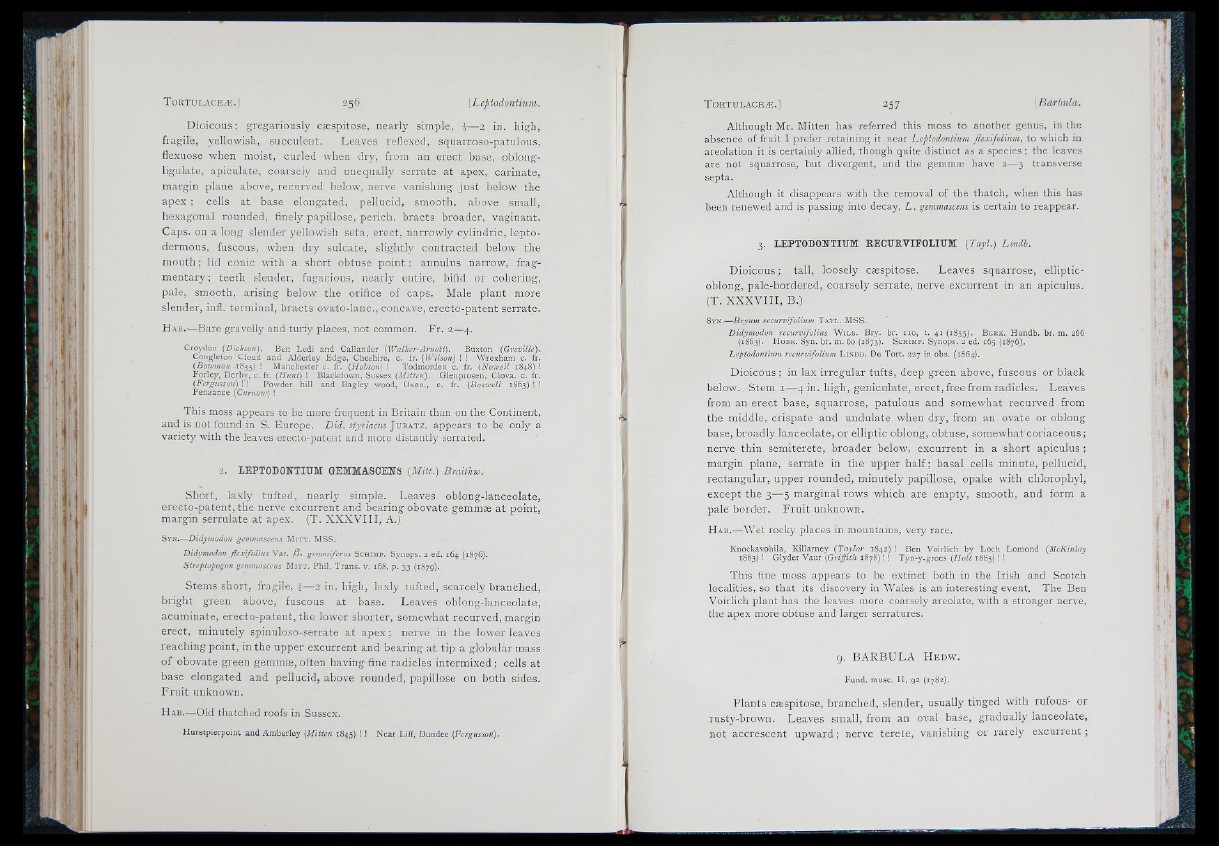
î
’I
I •
Í *
I
•! ’
II» I
111
M I.
D io ico u s ; greg ariously cæspitose, nearly simple, i — 3 in. Iiigli,
fragile, jællowish, succulent. L e a v e s rellexed, squarroso-patiilous,
flexuose when moist, curled when dry, from an erect base, oblong-
ligulate, apiculate, co a rse ly and unequally serrate at apex, carinate,
margin plane above, recurved below, nerve vanishing ju s t below the
apex ; cells at base e longated, pellucid, smooth, above small,
hexagonal rounded, finely papillose, perich. bra cts broader, v aginant.
Caps, on a long slender yellowish seta, erect, narrowly cylind ric , le p to dermous,
fuscous, when dry sulcate, slightly contra c ted below the
mouth ; lid conic with a short obtuse point ; annulus narrow, fragmentary
; teeth slender, fugacious, nearly entire, bifid or cohering,
pale, smooth, arising below the orifice o f caps. Male plant more
slender, infl. terminal, b ra cts ovato-lan c., concave, erecto-patent serrate.
H.ab.— B are gravelly and turfy places, not common. Fr. 2— 4.
Croydon {Dickson). Ben Ledi and Callander [Walker-Arnott). Buxton {GreviUe).
Congleton Cloud and Alderley Edge, Cheshire, c. fr. {Wilson) ! ! Wrexham c. fr.
{Bowman 1S35) I Manchester c. fr. {Hobson) ! Todmorden c. fr. {Nowell 1848) !
Forley, Derby, c. fr. {Hunt) ! Blackdown, Sussex (Mitten). Glenprosen, Clova. c. fr.
(Fergusson) ! ! Powder hill and Bagley wood, Oxon., c. fr. {Boswell 1863) ! !
Penzance (Curnozv) !
This moss appears to be more frequent in Britain than on the Continent,
and is not found in S. Europe. Did. stynactis J u r a t z . appears to be only a
variety with the leaves erecto-patent and more distantly serrated.
2. LEPTODONTIUM GEMMASCENS (Mitt.) Braithw.
Short, la xly tufted, nearly simple. L e a v e s oblong-lanceolate,
erecto-patent, the nerve excur rent and bearing obovate gemmæ at point,
margin serrulate at apex. (T. X X X V II I, A.)
S y n .— Didymodon gemmascens M i t t . MSS.
Didymodon ficxifolius Var. fi- gcmmiferus S c h im p . Synops. 2 ed. 164 (1876).
Streptopogon gemmascens M i t t . Phil. Trans, v . 168, p. 33 (18 79).
Stems short, fragile, 4— 2 in. high, la xly tufted, s ca rce ly branched,
bright green above, fuscous at base. L e a v e s oblong-lanceolate,
acuminate, erecto-patent, the lower shorter, somewhat recurved, margin
erect, minutely spinuloso-serrate at a p e x ; nerve in the lower leaves
rea ching point, in the upper excurrent and bearing at tip a globula r mass
o f obovate green gemmæ, often having fine radic les intermixed ; cells at
base elongated and pellucid, above rounded, papillose on both sides.
F ru it unknown.
Hab.— Old thatched roofs in Sussex.
Hurstpierpoinl and Amberley (Mitten 1845) ! ! Near Liff, Dundee (Fergusson).
Although Mr. Mitten has referred this moss to another genus, in the
absence of fruit I prefer retaining it near Leptodontium flexifolium, to which in
areolation it is certainly allied, though quite distinct as a species ; the leaves
are not squarrose, but divergent, and the gemmæ have 2— 3 transverse
septa.
Although it disappears with the removal of the thatch, when this has
been renewed and is passing into decay, L . gemmascens is certain to reappear.
3. LEPTODONTIUM EECUUVIFOLIUM (Tayl.) Lindb.
Dio icous ; tall, loosely cæspitose. Le a v e s squarrose, elliptic-
oblong, pale-bordered, coarsely serrate, nerve excurrent in an apiculus,
(T. X X X V I I I , B.)
S y n .— Bryum recurvifolium T a y l . MSS.
Didymodon recurvifolius W i l s . Bry. br. n o , t. 41 (1855). B e r k . Handb. br. m. 266
(1863}. H o b k . Syn. b r . m . 60 {1873). S c h im p . Synops. 2 ed. 165 (1876).
Leptodontium recurvifolium L in d b . De Tort. 227 in obs. (1864).
Dioicous ; in lax irregular tufts, deep green above, fuscous or black
below. Stem r— 4 in. high, gen iculate, erect, free from radic les. Lea ves
from an erect base, squarrose, patulous and somewhat recurved from
the middle, críspate and undulate when dry, from an ovate or oblong
base, broadly lanceolate, or ellip tic oblong, obtuse, somewhat coria ceous;
nerve thin semiterete, broader below, excurrent in a short apiculus ;
margin plane, serrate in th e upper h a lf ; basal cells minute, pellucid,
rectangular, upper rounded, minutely papillose, opake with chlorophyl,
exc ep t the 3— 5 marginal rows which are empty, smooth, and form a
pale border. F ru it unknown.
H a b .— We t rocky places in mountains, very rare.
Knockavohila, Killarney (Taylor 1842) ! Ben Voirlich by Loch Lomond (McKinlay
1863) ! Glyder Vaur {Griffith 1878) ! ! Tyn-y-groes {Holt 1885) ! !
This fine moss appears to be extinct both in the Irish and Scotch
localities, so that its discovery in Wales is an interesting event. The Ben
Voirlich plant has the leaves more coarsely areolate, with a stronger nerve,
the apex more obtuse and larger serratures.
g. B A R B U L A H e dw .
Fund. musc. II, 92 {1782).
Plants cæspitose, branched, slender, usually tinged with rufous- or
rusty-brown. L e a v e s small, from an oval base, gradua lly lanceolate,
not ac c re scent upward ; nerve terete, vanishing or rarely excurrent ;